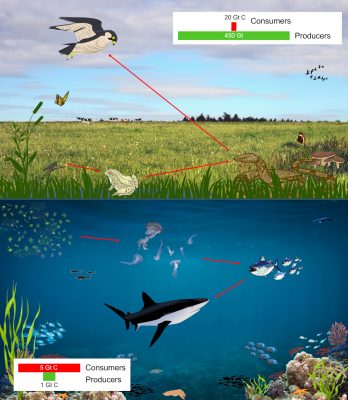3.3: Biomass of producers and consumers
- Page ID
- 25877
\( \newcommand{\vecs}[1]{\overset { \scriptstyle \rightharpoonup} {\mathbf{#1}} } \)
\( \newcommand{\vecd}[1]{\overset{-\!-\!\rightharpoonup}{\vphantom{a}\smash {#1}}} \)
\( \newcommand{\id}{\mathrm{id}}\) \( \newcommand{\Span}{\mathrm{span}}\)
( \newcommand{\kernel}{\mathrm{null}\,}\) \( \newcommand{\range}{\mathrm{range}\,}\)
\( \newcommand{\RealPart}{\mathrm{Re}}\) \( \newcommand{\ImaginaryPart}{\mathrm{Im}}\)
\( \newcommand{\Argument}{\mathrm{Arg}}\) \( \newcommand{\norm}[1]{\| #1 \|}\)
\( \newcommand{\inner}[2]{\langle #1, #2 \rangle}\)
\( \newcommand{\Span}{\mathrm{span}}\)
\( \newcommand{\id}{\mathrm{id}}\)
\( \newcommand{\Span}{\mathrm{span}}\)
\( \newcommand{\kernel}{\mathrm{null}\,}\)
\( \newcommand{\range}{\mathrm{range}\,}\)
\( \newcommand{\RealPart}{\mathrm{Re}}\)
\( \newcommand{\ImaginaryPart}{\mathrm{Im}}\)
\( \newcommand{\Argument}{\mathrm{Arg}}\)
\( \newcommand{\norm}[1]{\| #1 \|}\)
\( \newcommand{\inner}[2]{\langle #1, #2 \rangle}\)
\( \newcommand{\Span}{\mathrm{span}}\) \( \newcommand{\AA}{\unicode[.8,0]{x212B}}\)
\( \newcommand{\vectorA}[1]{\vec{#1}} % arrow\)
\( \newcommand{\vectorAt}[1]{\vec{\text{#1}}} % arrow\)
\( \newcommand{\vectorB}[1]{\overset { \scriptstyle \rightharpoonup} {\mathbf{#1}} } \)
\( \newcommand{\vectorC}[1]{\textbf{#1}} \)
\( \newcommand{\vectorD}[1]{\overrightarrow{#1}} \)
\( \newcommand{\vectorDt}[1]{\overrightarrow{\text{#1}}} \)
\( \newcommand{\vectE}[1]{\overset{-\!-\!\rightharpoonup}{\vphantom{a}\smash{\mathbf {#1}}}} \)
\( \newcommand{\vecs}[1]{\overset { \scriptstyle \rightharpoonup} {\mathbf{#1}} } \)
\( \newcommand{\vecd}[1]{\overset{-\!-\!\rightharpoonup}{\vphantom{a}\smash {#1}}} \)

Figure \(\PageIndex{1}\). Example of food chains and biomass distribution (in Gt C) in terrestrial (top) and marine (bottom) environments. The producers are autotrophs, mainly photosynthetic, and the consumers are heterotrophs. [Source: © EEnv diagrams]
Figure \(\PageIndex{1}\) shows the distribution of biomass between producers (autotrophs) and consumers (heterotrophs) in the terrestrial and marine ecosystems. All heterotrophic organisms, including detritivores, are part of the consumer biomass.
In the terrestrial environment, plant biomass represents the total biomass of terrestrial autotrophs. The remaining terrestrial biomass, including soil bacteria (≈7 Gt C), soil archaea (≈0.5 Gt C), soil fungi (≈12 Gt C), soil protists (≈1.5 Gt C), and terrestrial animals (≈0.5 Gt C), are considered terrestrial heterotrophs (See Focus Soil biomass).
In the marine environment, the total biomass of seagrasses (≈0.1 Gt C), macroalgae (≈0.1 Gt C), picoplankton (≈0.4 Gt C), diatoms (≈0.3 Gt C), and Phaeocystis (≈0.3 Gt C) yields an estimate of total marine autotroph biomass of ≈1.3 Gt C. The remaining marine biomass of ≈5 Gt C including marine bacteria (≈1.3 Gt C), archaea (≈0.3 Gt C), fungi (≈0.3 Gt C), heterotrophic protists (≈1.1 Gt C), and animals (≈2 Gt C), was considered as marine heterotrophic biomass.
This study confirms a well-known observation in ecology: in oceans, the biomass of consumers far exceeds that of producers (≈5 Gt C versus ≈1 Gt C). Conversely, on land, the biomass of primary producers is much larger than that of primary and secondary consumers (Figure 9).
Such inverted biomass distribution in the oceans can be explained by a higher turnover rate of producers than consumers: marine primary producers renew their biomass rapidly (on the order of a few days [29], whereas consumers renew their biomass only much more slowly, a few years in the case of mesopelagic fish [30]). Thus, the standing stock of consumers is larger, even though the productivity of producers is necessarily higher. Inverted consumer/producer ratio has also been described for the global plankton biomass [31]. This holds true when considering the overall biomass of all producers and consumers in the marine environment.
It should be noted that the biomass of parasites is not yet separated from that of their hosts. It might be larger than the biomass of top predators in some environments [32].

